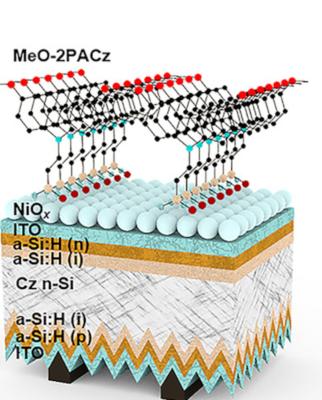Researchers from China's Jinan University, University of Macau, Wuyi University, Guangdong Mellow Energy and Germany's IEK-5 Photovoltaik (Forschungszentrum Jülich) recently designed a two-terminal perovskite-silicon tandem solar cell that utilizes new hybrid interconnecting layers to reduce recombination losses in the top perovskite device. The tandem cell achieved an impressive fill factor of 81.8%, which the scientists said is the highest value ever reported for this cell technology to date.
The team's 2T perovskite-silicon tandem solar cell is based on special hybrid interconnecting layers (ICLs) that prevent direct contact between the perovskite absorber and transparent conductive oxide (TCO). The scientists' approach is based on sputtered nickel oxide (NiOx) as the seed layer of SAMs to build the hybrid interconnecting layers. The sputtered treatment technique provides, according to the team, an easy coating on a complex substrate and high reproducibility.
According to the researchers, NiOx materials can further increase the coupling of SAM molecules with the substrate. Thus, the hybrid ICLs could improve the uniformity of the interface between the TCO and the SAM based on MeO-2PACz, which is also known as [2-(3,6-Dimethoxy-9H-carbazol-9-yl)ethyl]phosphonic acid, and reduce the leakage current. This enables a good energy level alignment between the perovskite and hybrid ICLs, which is beneficial to carrier extraction and transportation. The hybrid ICLs assist in further decreasing the interface defects and bulk defects.
The scientists built the tandem cell with a bottom silicon heterojunction device and a 19.73%-efficient top inverted perovskite solar cell with an energy bandgap of 1.71 eV integrating the ICLs. The latter was designed with a substrate made of indium tin oxide (ITO), a hole transport layer (HTL) made of nickel(II) oxide (NiOx), the MeO-2PACz SAM, a perovskite absorber doped with 2-phenylethylammonium iodide (PEAI), an electron transport layer (ETL) based on a buckminsterfullerene (C60), a transparent back contact made of indium zinc oxide (IZO), and a silver (Ag) metal contact.
The performance of the tandem device was analyzed and compared to that of a refence cell based on a NiOx HTL but without the MeO-2PACz SAM. The latter achieved a power conversion efficiency of 22.27%, an open-circuit voltage of 1.75 V, a short-circuit current density of 17.85 mA cm−2, and a fill factor of 71.15%. The former obtained an efficiency of 28.47%, an open-circuit voltage of 1.88 V, a short-circuit current density of 18.25 mA cm−2, and a fill factor of 81.8%.


